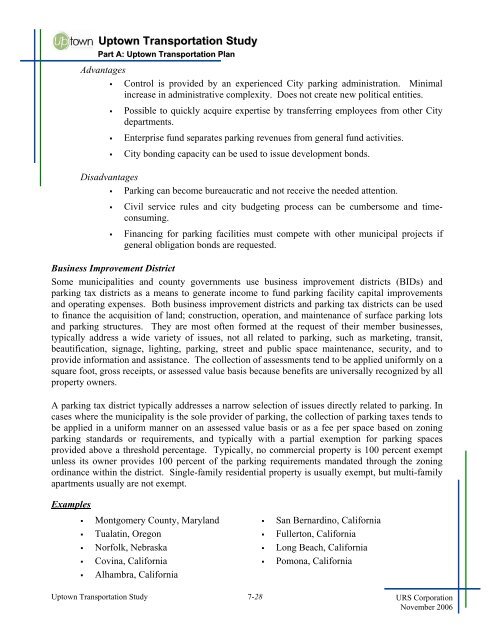Uptown Transportation Study CHAPTER 7: PARKING - OKI
Uptown Transportation Study CHAPTER 7: PARKING - OKI
Uptown Transportation Study CHAPTER 7: PARKING - OKI
You also want an ePaper? Increase the reach of your titles
YUMPU automatically turns print PDFs into web optimized ePapers that Google loves.
<strong>Uptown</strong> <strong>Transportation</strong> <strong>Study</strong>Part A: <strong>Uptown</strong> <strong>Transportation</strong> PlanAdvantages• Control is provided by an experienced City parking administration. Minimalincrease in administrative complexity. Does not create new political entities.• Possible to quickly acquire expertise by transferring employees from other Citydepartments.• Enterprise fund separates parking revenues from general fund activities.• City bonding capacity can be used to issue development bonds.Disadvantages• Parking can become bureaucratic and not receive the needed attention.• Civil service rules and city budgeting process can be cumbersome and timeconsuming.• Financing for parking facilities must compete with other municipal projects ifgeneral obligation bonds are requested.Business Improvement DistrictSome municipalities and county governments use business improvement districts (BIDs) andparking tax districts as a means to generate income to fund parking facility capital improvementsand operating expenses. Both business improvement districts and parking tax districts can be usedto finance the acquisition of land; construction, operation, and maintenance of surface parking lotsand parking structures. They are most often formed at the request of their member businesses,typically address a wide variety of issues, not all related to parking, such as marketing, transit,beautification, signage, lighting, parking, street and public space maintenance, security, and toprovide information and assistance. The collection of assessments tend to be applied uniformly on asquare foot, gross receipts, or assessed value basis because benefits are universally recognized by allproperty owners.A parking tax district typically addresses a narrow selection of issues directly related to parking. Incases where the municipality is the sole provider of parking, the collection of parking taxes tends tobe applied in a uniform manner on an assessed value basis or as a fee per space based on zoningparking standards or requirements, and typically with a partial exemption for parking spacesprovided above a threshold percentage. Typically, no commercial property is 100 percent exemptunless its owner provides 100 percent of the parking requirements mandated through the zoningordinance within the district. Single-family residential property is usually exempt, but multi-familyapartments usually are not exempt.Examples• Montgomery County, Maryland• Tualatin, Oregon• Norfolk, Nebraska• Covina, California• Alhambra, California• San Bernardino, California• Fullerton, California• Long Beach, California• Pomona, California<strong>Uptown</strong> <strong>Transportation</strong> <strong>Study</strong> 7-28 URS CorporationNovember 2006
















